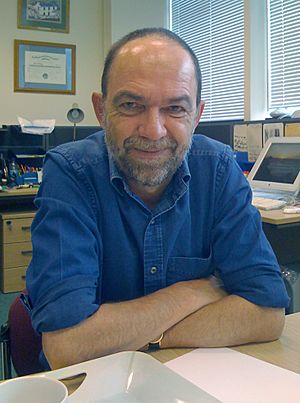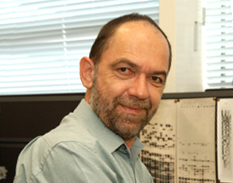Alec Jeffreys facts for kids
Quick facts for kids
Sir
Alec Jeffreys
|
|
|---|---|

Alec Jeffreys, 2009
|
|
| Born | 9 January 1950 Oxford, Oxfordshire, England
|
| Education | University of Oxford (BA, DPhil) |
| Known for | Genetic fingerprinting |
| Spouse(s) |
Susan Miles
(m. 1971) |
| Awards |
|
| Scientific career | |
| Fields | Genetics |
| Institutions | |
| Thesis | Studies on the mitochondria of cultured mammalian cells (1975) |
Sir Alec John Jeffreys is a famous British geneticist. He was born on January 9, 1950. He is best known for inventing genetic fingerprinting and DNA profiling. These amazing techniques are used all over the world today.
They help police solve crimes and figure out family relationships. Sir Alec is a professor at the University of Leicester. He was knighted by Queen Elizabeth II in 1994 for his important work.
Contents
Early Life and Education
Alec Jeffreys grew up in Oxford and then Luton, England. He says he got his curiosity from his dad and grandpa. When he was eight, his dad gave him a chemistry set. He loved making small explosions with it!
He also had a Victorian-era microscope. He used it to look at tiny living things. Once, he even tried to dissect a bumblebee. Another time, he found a deceased cat and brought it home. He started to dissect it on the dining room table, which caused a big smell! His parents were not happy.
Alec went to Luton Grammar School. He then earned a scholarship to Merton College, Oxford. He studied biochemistry and graduated in 1971. Later, he earned his PhD from the University of Oxford. His research focused on cells.
Career and Discoveries
After finishing his studies, Alec Jeffreys worked in Amsterdam. He then moved to the University of Leicester in 1977. It was there, in 1984, that he made his big discovery. He found a way to see differences in people's DNA. This led to the invention of genetic fingerprinting.
What is Genetic Fingerprinting?
Sir Alec Jeffreys had a "eureka moment" on September 10, 1984. He was looking at an X-ray image from a DNA experiment. He saw that the DNA from a family showed both similarities and differences. He quickly realized how powerful this could be.
DNA fingerprinting uses tiny differences in our genetic information. These differences can identify individuals. It's like a unique barcode for each person. This method became very important in forensic science. It helps police solve difficult cases. It also helps settle arguments about who a child's parents are.
Before 1987, only his lab could do DNA fingerprinting. They were very busy with requests from all over the world.
How DNA Fingerprinting Helps Solve Crimes
One of the first times DNA fingerprinting was used was in 1985. Sir Alec helped an immigration case. He proved a boy was related to his family in Britain. The boy's mother was very relieved.
DNA fingerprinting was also first used by police in 1987. It helped identify the person responsible for serious crimes in Leicestershire. The police used DNA samples to find the killer. This case was very important. It showed how DNA evidence could help solve crimes and clear innocent people. The story of this case has been featured in books and TV shows.
In 1992, Jeffreys' methods helped identify the body of Josef Mengele. DNA from his bones was compared to his family's DNA. This was similar to how paternity tests work.
Understanding DNA Profiling
Sir Alec Jeffreys and his team also developed DNA profiling in 1985. This method focuses on just a few specific parts of DNA. It made the system more sensitive and easier to use with computers. DNA profiling quickly became the main way to use DNA in criminal cases. It is also used for paternity testing worldwide.
New technologies, like polymerase chain reaction (PCR), made DNA testing even better. They allowed for faster and more sensitive tests. Today, scientists use tiny repeating DNA sections called short tandem repeats (STRs). Sir Alec first used STRs in the Mengele case in 1990.
The UK National DNA Database (NDNAD) was started in 1995. It uses STR profiling. Modern DNA profiling can process hundreds of samples daily. The current system uses 16 STR markers. This makes it incredibly powerful for identifying people. In the UK, DNA profiles are stored on this database. As of 2020, it held information for about 5.6 million people.
Sir Alec Jeffreys has shared his thoughts on how this database is used. He believes an independent group should control access to it.
Awards and Recognition
Sir Alec Jeffreys has received many awards for his groundbreaking work. Here are some of them:
- 1986 – Elected a Fellow of the Royal Society (FRS)
- 1994 – Knighted for his contributions to genetics.
- 1996 – Albert Einstein World Award of Science.
- 2004 – Royal Medal of the Royal Society.
- 2004 – Louis-Jeantet Prize for Medicine.
- 2005 – Albert Lasker Award for Clinical Medical Research.
- 2006 – Great Briton Award for the Greatest Briton of the year.
- 2014 – Copley Medal.
- 2017 – Member of the Order of the Companions of Honour.
Personal Life
Alec Jeffreys met his wife, Sue Miles, at a youth club in Luton. They got married on August 28, 1971. They have two daughters, born in 1979 and 1983.
See also
 In Spanish: Alec Jeffreys para niños
In Spanish: Alec Jeffreys para niños


